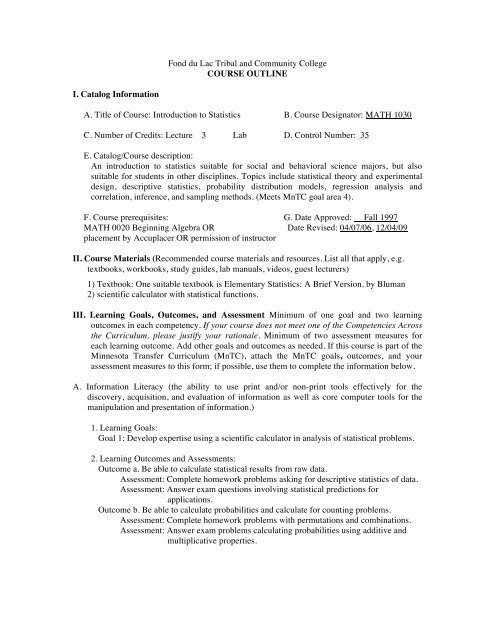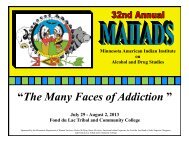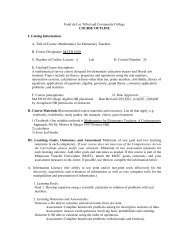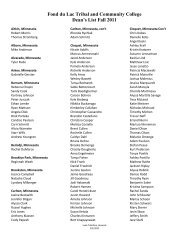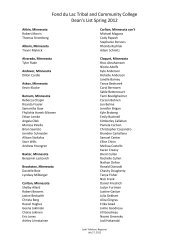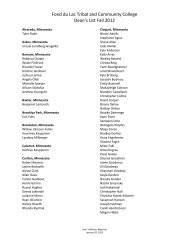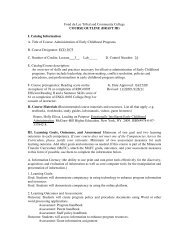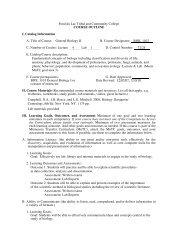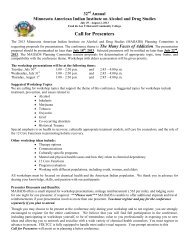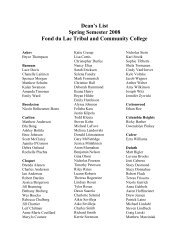MATH 1030 Introduction to Statistics - Fond Du Lac Tribal and ...
MATH 1030 Introduction to Statistics - Fond Du Lac Tribal and ...
MATH 1030 Introduction to Statistics - Fond Du Lac Tribal and ...
Create successful ePaper yourself
Turn your PDF publications into a flip-book with our unique Google optimized e-Paper software.
<strong>Fond</strong> du <strong>Lac</strong> <strong>Tribal</strong> <strong>and</strong> Community College<br />
COURSE OUTLINE<br />
I. Catalog Information<br />
A. Title of Course: <strong>Introduction</strong> <strong>to</strong> <strong>Statistics</strong> B. Course Designa<strong>to</strong>r: <strong>MATH</strong> <strong>1030</strong><br />
C. Number of Credits: Lecture 3 Lab D. Control Number: 35<br />
E. Catalog/Course description:<br />
An introduction <strong>to</strong> statistics suitable for social <strong>and</strong> behavioral science majors, but also<br />
suitable for students in other disciplines. Topics include statistical theory <strong>and</strong> experimental<br />
design, descriptive statistics, probability distribution models, regression analysis <strong>and</strong><br />
correlation, inference, <strong>and</strong> sampling methods. (Meets MnTC goal area 4).<br />
F. Course prerequisites: G. Date Approved: Fall 1997<br />
<strong>MATH</strong> 0020 Beginning Algebra OR Date Revised: 04/07/06, 12/04/09<br />
placement by Accuplacer OR permission of instruc<strong>to</strong>r<br />
II. Course Materials (Recommended course materials <strong>and</strong> resources. List all that apply, e.g.<br />
textbooks, workbooks, study guides, lab manuals, videos, guest lecturers)<br />
1) Textbook: One suitable textbook is Elementary <strong>Statistics</strong>: A Brief Version. by Bluman<br />
2) scientific calcula<strong>to</strong>r with statistical functions.<br />
III. Learning Goals, Outcomes, <strong>and</strong> Assessment Minimum of one goal <strong>and</strong> two learning<br />
outcomes in each competency. If your course does not meet one of the Competencies Across<br />
the Curriculum, please justify your rationale. Minimum of two assessment measures for<br />
each learning outcome. Add other goals <strong>and</strong> outcomes as needed. If this course is part of the<br />
Minnesota Transfer Curriculum (MnTC), attach the MnTC goals, outcomes, <strong>and</strong> your<br />
assessment measures <strong>to</strong> this form; if possible, use them <strong>to</strong> complete the information below.<br />
A. Information Literacy (the ability <strong>to</strong> use print <strong>and</strong>/or non-print <strong>to</strong>ols effectively for the<br />
discovery, acquisition, <strong>and</strong> evaluation of information as well as core computer <strong>to</strong>ols for the<br />
manipulation <strong>and</strong> presentation of information.)<br />
1. Learning Goals:<br />
Goal 1: Develop expertise using a scientific calcula<strong>to</strong>r in analysis of statistical problems.<br />
2. Learning Outcomes <strong>and</strong> Assessments:<br />
Outcome a. Be able <strong>to</strong> calculate statistical results from raw data.<br />
Assessment: Complete homework problems asking for descriptive statistics of data.<br />
Assessment: Answer exam questions involving statistical predictions for<br />
applications.<br />
Outcome b. Be able <strong>to</strong> calculate probabilities <strong>and</strong> calculate for counting problems.<br />
Assessment: Complete homework problems with permutations <strong>and</strong> combinations.<br />
Assessment: Answer exam problems calculating probabilities using additive <strong>and</strong><br />
multiplicative properties.
B. Ability <strong>to</strong> Communicate (the ability <strong>to</strong> listen, read, comprehend, <strong>and</strong>/or deliver information in<br />
a variety of formats.)<br />
Communication as a general goal is not addressed directly in mathematics courses.<br />
C. Problem Solving (the ability <strong>to</strong> conceptualize, apply, analyze, synthesize, <strong>and</strong>/or evaluate<br />
information <strong>to</strong> formulate <strong>and</strong> solve problems.)<br />
1. Learning Goals:<br />
Goal 1: Solve applied problems by analysis, mathematical technique, <strong>and</strong> reporting<br />
results.<br />
2. Learning Outcomes <strong>and</strong> Assessments:<br />
Outcome a. Be able <strong>to</strong> solve applied problems with graphical analysis.<br />
Assessment: Solve homework exercises involving plotting of data.<br />
Assessment: Answer exam problems with descriptive graphs.<br />
Outcome b. Be able <strong>to</strong> translate word problems in<strong>to</strong> equations for technical solution.<br />
Assessment: Complete homework problems using sampling techniques.<br />
Assessment: Answer exam problems requiring regression analysis.<br />
D. Culture (knowledge of Anishinaabe traditions <strong>and</strong> culture, knowledge of one’s own traditions<br />
<strong>and</strong> culture, knowledge of others’ traditions <strong>and</strong> cultures, <strong>and</strong>/or respect for global diversity.)<br />
Culture is not directly addressed in mathematics courses.<br />
Documentation for MnTC<br />
Goal 4: Mathematical/Logical Reasoning<br />
IV. Course Content (Outline the major <strong>to</strong>pics covered in this course.)<br />
1. <strong>Introduction</strong> <strong>to</strong> set theory <strong>and</strong> counting.<br />
2. Simple probability models.<br />
3. Normal distribution models.<br />
4. Descriptive statistics.<br />
5. Other probability models.<br />
6. Regression analysis <strong>and</strong> correlation.<br />
7. Sampling techniques.<br />
(revised Oc<strong>to</strong>ber 2009)


